OCM考试题库
- 格式:pdf
- 大小:732.43 KB
- 文档页数:23

计算机考试题库和答案一级office一、单项选择题(每题2分,共10题)1. 在Word中,下列哪个功能可以用于查找文档中的特定文字?A. 插入B. 引用C. 查找D. 视图答案:C2. Excel中,哪个函数用于计算一组数值的平均值?A. SUMB. AVERAGEC. COUNTD. MAX答案:B3. 在PowerPoint中,下列哪个视图模式用于编辑幻灯片的详细内容?A. 普通视图B. 幻灯片浏览视图C. 幻灯片放映视图D. 大纲视图答案:A4. Word文档中,如何将文本格式设置为粗体?A. 选中文本,按Ctrl+BB. 选中文本,按Ctrl+IC. 选中文本,按Ctrl+UD. 选中文本,按Ctrl+P答案:A5. Excel中,如何插入一个新的工作表?A. 点击“插入”选项卡,选择“工作表”B. 点击“页面布局”选项卡,选择“工作表”C. 点击“数据”选项卡,选择“工作表”D. 点击“视图”选项卡,选择“工作表”答案:A6. PowerPoint中,如何将一张幻灯片复制到新的幻灯片?A. 选中幻灯片,按Ctrl+C,然后按Ctrl+VB. 选中幻灯片,按Ctrl+X,然后按Ctrl+VC. 选中幻灯片,右键点击,选择“复制幻灯片”D. 选中幻灯片,右键点击,选择“粘贴幻灯片”答案:C7. Word中,如何设置页眉和页脚?A. 点击“插入”选项卡,选择“页眉和页脚”B. 点击“引用”选项卡,选择“页眉和页脚”C. 点击“设计”选项卡,选择“页眉和页脚”D. 点击“视图”选项卡,选择“页眉和页脚”答案:B8. Excel中,如何快速填充一系列连续的数字?A. 使用“序列”功能B. 使用“填充”功能C. 使用“自动填充”功能D. 使用“数据”选项卡中的“序列”功能答案:C9. PowerPoint中,如何将一张图片设置为幻灯片的背景?A. 选中图片,点击“格式”选项卡,选择“背景”B. 选中图片,点击“插入”选项卡,选择“背景”C. 选中图片,点击“设计”选项卡,选择“背景”D. 选中图片,点击“视图”选项卡,选择“背景”答案:C10. Word中,如何将文本对齐方式设置为居中?A. 选中文本,点击“开始”选项卡中的“居中”按钮B. 选中文本,点击“插入”选项卡中的“居中”按钮C. 选中文本,点击“引用”选项卡中的“居中”按钮D. 选中文本,点击“设计”选项卡中的“居中”按钮答案:A二、多项选择题(每题3分,共5题)1. 在Excel中,下列哪些操作可以对数据进行排序?A. 点击“数据”选项卡,选择“排序”B. 使用快捷键Ctrl+A全选数据,然后按F5键C. 使用“筛选”功能进行排序D. 使用“排序和筛选”功能进行排序答案:A, D2. PowerPoint中,下列哪些视图模式可以用于编辑幻灯片?A. 普通视图B. 幻灯片浏览视图C. 幻灯片放映视图D. 大纲视图答案:A, D3. Word中,下列哪些选项卡包含用于插入表格的功能?A. 插入B. 引用C. 设计D. 视图答案:A4. Excel中,下列哪些函数用于计算数值?A. SUMB. AVERAGEC. CONCATENATED. COUNT答案:A, B, D5. PowerPoint中,下列哪些操作可以改变幻。

计算机网络技术考试题库带答案(后面有答案)第1章计算机网络的基本概念一、选择题:1、计算机网络是计算机技术和通信技术相结合的产物,这种结合开始于( )。
A.20世纪50年代B.20世纪60年代初期C.20世纪60年代中期D.20世纪70年代2、第二代计算机网络的主要特点是( )。
A.计算机-计算机网络B.以单机为中心的联机系统C.国际网络体系结构标准化D.各计算机制造厂商网络结构标准化3、计算机网络中可以共享的资源包括( )。
A.硬件、软件、数据B.主机、外设、软件C.硬件、程序、数据D.主机、程序、数据4、计算机网络在逻辑上可以分为( )。
A.通信子网与共享子网B.通信子网与资源子网C.主从网络与对等网络D.数据网络与多媒体网络5、一座大楼内的一个计算机网络系统,属于( )。
A. PANNC.MAND. WAN6、下列网络中,传输速度最慢的是( )。
A.局域网B.城域网C.广域网D.三者速率差不多9、局域网具有的几种典型的拓扑结构中,一般不含( )。
A. 星型B. 环型C.总线型D.全连接网型10、若网络形状是由站点和连接站点的链路组成的一个闭合环,则称这种拓扑结构为( )。
A.星形拓扑B.总线拓扑C.环形拓扑D.树形拓扑11、在计算机网络中,所有的计算机均连接到一条通信传输线路上,在线路两端连有防止信号反射的装置。
这种连接结构被称为( )。
A.总线结构B.环型结构C.星型结构D.网状结构12、在下列网络拓扑结构中,中心节点的故障可能造成全网瘫痪的是( )。
A.星型拓扑结构B.环型拓扑结构C.树型拓扑结构D.网状拓扑结构13、下列属于星型拓扑的优点的是( )。
A.易于扩展B.电缆长度短C.不需接线盒D.容错性高二、填空题:2、计算机网络的功能有数据通信、()、实现分布式的信息处理和提高计算机系统的可靠性和可用性。
3、计算机网络是由负责信息处理并向全网提供可用资源的()和负责信息传输的通信子网组成。

第1篇第一部分:基础知识测试一、单选题1. 下列关于TCP/IP协议栈的说法,错误的是:()A. TCP/IP协议栈分为应用层、传输层、网络层、数据链路层和物理层B. TCP协议提供面向连接的服务,IP协议提供无连接的服务C. TCP协议使用三次握手建立连接,四次挥手终止连接D. IP协议负责数据包的传输,确保数据包的可靠到达2. 在下列网络设备中,用于连接局域网和广域网的设备是:()A. 路由器B. 交换机C. 网桥D. 集线器3. 下列关于IP地址的说法,错误的是:()A. IP地址是一个32位的二进制数B. IP地址分为A、B、C、D、E五类C. A类地址的网络地址部分占8位,主机地址部分占24位D. B类地址的网络地址部分占16位,主机地址部分占16位4. 在下列关于DNS的说法中,错误的是:()A. DNS用于将域名解析为IP地址B. DNS服务器负责解析域名C. DNS查询过程分为递归查询和迭代查询D. DNS解析过程中,每次查询都直接访问根域名服务器5. 下列关于HTTP协议的说法,错误的是:()A. HTTP协议是无状态的B. HTTP协议使用TCP协议作为传输层协议C. HTTP请求包括请求行、请求头和请求体D. HTTP响应包括状态行、响应头和响应体二、多选题1. 下列关于OSI七层模型的说法,正确的是:()A. OSI七层模型是一个抽象模型,用于描述网络通信的过程B. 物理层负责传输原始比特流C. 数据链路层负责在相邻节点之间传输数据D. 应用层负责为用户提供网络服务2. 下列关于TCP协议的说法,正确的是:()A. TCP协议提供面向连接的服务B. TCP协议使用三次握手建立连接C. TCP协议使用滑动窗口机制实现流量控制D. TCP协议使用校验和机制实现数据完整性校验3. 下列关于IP地址的说法,正确的是:()A. IP地址分为A、B、C、D、E五类B. A类地址的网络地址部分占8位,主机地址部分占24位C. B类地址的网络地址部分占16位,主机地址部分占16位D. C类地址的网络地址部分占24位,主机地址部分占8位4. 下列关于DNS的说法,正确的是:()A. DNS用于将域名解析为IP地址B. DNS服务器负责解析域名C. DNS查询过程分为递归查询和迭代查询D. DNS解析过程中,每次查询都直接访问根域名服务器5. 下列关于HTTP协议的说法,正确的是:()A. HTTP协议是无状态的B. HTTP协议使用TCP协议作为传输层协议C. HTTP请求包括请求行、请求头和请求体D. HTTP响应包括状态行、响应头和响应体第二部分:编程能力测试一、编程题1. 编写一个Python程序,实现以下功能:- 输入一个字符串,输出该字符串的长度- 输入一个整数,输出该整数的阶乘- 输入一个字符串,输出该字符串的逆序2. 编写一个Java程序,实现以下功能:- 定义一个学生类,包含姓名、年龄、成绩三个属性- 定义一个学生管理类,实现添加、删除、查询学生信息的功能3. 编写一个C语言程序,实现以下功能:- 输入一个整数,输出该整数的二进制表示- 输入两个整数,输出它们的和、差、积、商4. 编写一个JavaScript程序,实现以下功能:- 输入一个整数,输出该整数的平方根- 输入两个整数,输出它们的最大公约数5. 编写一个Python程序,实现以下功能:- 输入一个字符串,输出该字符串的逆序- 输入一个整数,输出该整数的阶乘- 输入一个字符串,输出该字符串的长度第三部分:综合能力测试一、案例分析题1. 某公司需要开发一个基于Web的在线购物系统,要求具备以下功能: - 用户注册、登录、修改个人信息- 商品展示、搜索、分类- 购物车、订单、支付- 用户评论、收藏请根据以上需求,设计该系统的数据库表结构。

信息安全与管理(含信息安全法律法规)在线考试测试题库含答案一、单项选择题(每小题2分,共70分)基本信息:[矩阵文本题] *1. 考虑防火墙的安全性角度,最好的防火墙结构类型是() [单选题] *A、路由器型B、服务器型C、屏蔽主机机构D、屏蔽子网结构(正确答案)2. RSA加密算法不具有的优点是() [单选题] *A、可借助CA中心发放密钥,确保密钥发放的安全方便B、可进行用户认证C、可进行信息认证D、运行速度快,可用于大批量数据加密(正确答案)3. 黑客利用IP地址进行攻击的方法有:() [单选题] *A.IP欺骗(正确答案)B.解密C.窃取口令D.发送病毒4. CA指的是:() [单选题] *A.证书授权(正确答案)B.加密认证C.虚拟专用网D.安全套接层5. 入侵检测系统的第一步是:() [单选题] *A.信号分析B.信息收集(正确答案)C.数据包过滤D.数据包检查6. 以下哪一种方式是入侵检测系统所通常采用的:() [单选题] *A.基于网络的入侵检测(正确答案)B.基于IP的入侵检测C.基于服务的入侵检测D.基于域名的入侵检测7. 以下关于计算机病毒的特征说法正确的是:() [单选题] *A.计算机病毒只具有破坏性,没有其他特征B.计算机病毒具有破坏性,不具有传染性C.破坏性和传染性是计算机病毒的两大主要特征(正确答案)D.计算机病毒只具有传染性,不具有破坏性8. Windows 系统安装完后,默认情况下系统将产生两个账号,分别是管理员账号和() [单选题] *A.本地账号B.域账号C.来宾账号(正确答案)D.局部账号9. 以下关于VPN说法正确的是:() [单选题] *A.VPN指的是用户自己租用线路,和公共网络物理上完全隔离的、安全的线路B.VPN指的是用户通过公用网络建立的临时的、安全的连接(正确答案)C.VPN不能做到信息认证和身份认证D.VPN只能提供身份认证、不能提供加密数据的功能10. 当收到认识的人发来的电子邮件并发现其中有意外的附件时,应该:()[单选题] *A.打开附件,然后将它保存到硬盘B. 打开附件,但是如果它有病毒,立即关闭它C.用防病毒软件扫描以后再打开附件(正确答案)D.直接删除该邮件11. 所谓加密是指将一个信息经过()及加密函数转换,变成无意义的密文,而接受方则将此密文经过解密函数、()还原成明文。

一、单选题(每题 1 分,共 35 题) 0 1、公共危机管理的应急管理预案得以顺利实施的重要保障是( ) A、计划体系 B、指挥体系 C、组织体系 D、控制体系答案:正确答案:C 2、强调设置危机管理的常设机构并不排除极端特殊情况下成立公共危机管理的临时机构. 这句话的意思是指( ) A、统一领导与指挥原则 B、常设性原则 C、社会性大协作原则 D、属地管理原则答案:正确答案:B 3、“9.11”事件发生后,布什发表讲话:美国人民要透过泪水,看到历史带给我们的新希望。
这句话的意思是()。
A、对事件调查分析 B、对事件评价 C、对事件检查 D、对事件前瞻答案:正确答案:D 4、盖茨说:“微软离倒闭只有一百天” 这句话的意思是(。
)。
A、树立危机意识B、制定相关法律C、组建管理机构D、完善应急预案答案:正确答案:A 5、AD、理 B、在我国、政府救灾助残A、危C 10处理B 11、如果有B、模范作用正确答案:如果损害()。
A预警级别是依据突发公共事件可能造成的危害程度、紧急程度、()来分级。
A、伤亡程度 B、严重程度 C、发展事态 D、可控程度答案:正确答案:C 15、生产安全事故发生时,现场抢救的措施包括抢险救灾方案的确定;现场抢救的组织领导;实施抢救和()。
A、现场保护 B、预警方案确定 C、预警方案的组织实施 D、人员疏散答案:正确答案:A 16、建立危机预警机制时,要考虑政府治理能力、民众心里承受能力和大众传播媒介等诸多因素。
这是指()。
A、以人为本原则 B、常抓不懈原则 C、分级预警原则 D、讲究方法原则答案:正确答案:D 17、对可能出现危机事件的范围、影响程度进行科学分级,依法规范相关信息和数据的分级处理,宣布突发事件的级别,科学应对,达到预防和缓解的目的。
这是指()。
A、以人为本原则 B、常抓不懈原则 C、分级预警原则 D、讲究方法原则答案:正确答案:C 18、按照“谁主办、谁负责”的原则,由组织( )负责制定,按照有关规定重大活动应急预案,报公安机关批准后实施,并报当地人民政府备案。

电子商务师考试试题库及答案2017电子商务师考试试题库及答案1、谈到电子商务的起源,人类利用电子手段开展各种商务活动的时代最早是通过_______开始的。
[答案:C]A:互联网B:电话C:电报D:电视2、电子商务的标准英文缩写是_______。
[答案:B]A:EBB:ECC:EDID:DC3、INTERNET的前身最早是_____,它首次实现了一些异地计算机的数据共享。
[答案:C]A:INTRANETB:NSFNETC:ARPNETD:EXTRANET4、2000年6月21日____标志着我国电子商务的发展将进一步走向健康和规范。
[答案:A]A:中国电子商务协会的正式成立B:中国互联网大会的召开C:由信息产业部等单位主持召开了电子商务法律专题研讨会D:国家信息化推广协调办公室的成立5、2000年内,中国电信出口带宽将从50M提高到_____。
[答案:C]A:250MB:100MC:150MD:80M6、INTERNET是由先前的______更名而来的。
[答案:D]A:INTRANETB:EXTRANETC:ARPNETD:NSFNET7、亚太经合组织(APEC)已建了__,以监控本地区及全球各认证中心的发展。
[答案:D]A:亚洲认证协调中心B:认证中心授权系统C:亚洲各国认证机构联合会D:一个现有鉴证授权机构的数据库8、一般认为:________是最早出现的真正意义上的电子商务。
[答案:B]A:Spread SheetB:EDIC:EDPD:SSL9、1991年,美国三家公司组成了’商用Internet协会’(Commercial Internet Exchange Association),宣布用户可以把它们的Internet子网用于任何的商业用途,这标志了________。
[答案:A]A:Internet开始进入商业领域B:Internet的商业化彻底完成C:Internet已完全替代了NSFNETD:Internet已完全替代了ARPNET10、ARPAnet网络成功的最主要原因是其采用后来被称为互联网’通用语言’的______。
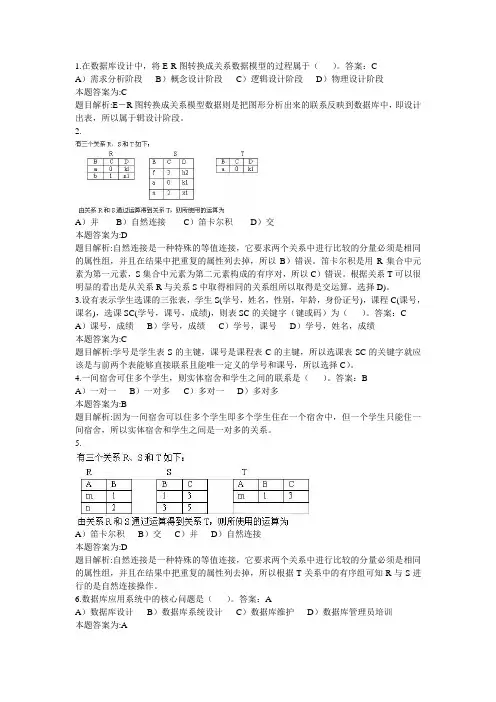
1.在数据库设计中,将E-R图转换成关系数据模型的过程属于()。
答案:CA)需求分析阶段B)概念设计阶段C)逻辑设计阶段D)物理设计阶段本题答案为:C题目解析:E-R图转换成关系模型数据则是把图形分析出来的联系反映到数据库中,即设计出表,所以属于辑设计阶段。
2.A)并B)自然连接C)笛卡尔积D)交本题答案为:D题目解析:自然连接是一种特殊的等值连接,它要求两个关系中进行比较的分量必须是相同的属性组,并且在结果中把重复的属性列去掉,所以B)错误。
笛卡尔积是用R集合中元素为第一元素,S集合中元素为第二元素构成的有序对,所以C)错误。
根据关系T可以很明显的看出是从关系R与关系S中取得相同的关系组所以取得是交运算,选择D)。
3.设有表示学生选课的三张表,学生S(学号,姓名,性别,年龄,身份证号),课程C(课号,课名),选课SC(学号,课号,成绩),则表SC的关键字(键或码)为()。
答案:C A)课号,成绩B)学号,成绩C)学号,课号D)学号,姓名,成绩本题答案为:C题目解析:学号是学生表S的主键,课号是课程表C的主键,所以选课表SC的关键字就应该是与前两个表能够直接联系且能唯一定义的学号和课号,所以选择C)。
4.一间宿舍可住多个学生,则实体宿舍和学生之间的联系是()。
答案:BA)一对一B)一对多C)多对一D)多对多本题答案为:B题目解析:因为一间宿舍可以住多个学生即多个学生住在一个宿舍中,但一个学生只能住一间宿舍,所以实体宿舍和学生之间是一对多的关系。
5.A)笛卡尔积B)交C)并D)自然连接本题答案为:D题目解析:自然连接是一种特殊的等值连接,它要求两个关系中进行比较的分量必须是相同的属性组,并且在结果中把重复的属性列去掉,所以根据T关系中的有序组可知R与S进行的是自然连接操作。
6.数据库应用系统中的核心问题是()。
答案:AA)数据库设计B)数据库系统设计C)数据库维护D)数据库管理员培训本题答案为:A题目解析:数据库应用系统中的核心问题是数据库的设计。
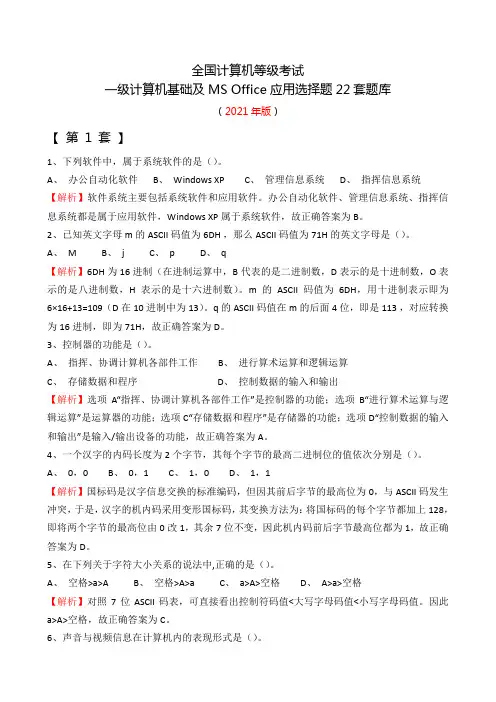
全国计算机等级考试一级计算机基础及MS Office应用选择题22套题库(2021年版)【第1 套】1、下列软件中,属于系统软件的是()。
A、办公自动化软件B、Windows XPC、管理信息系统D、指挥信息系统【解析】软件系统主要包括系统软件和应用软件。
办公自动化软件、管理信息系统、指挥信息系统都是属于应用软件,Windows XP属于系统软件,故正确答案为B。
2、已知英文字母m的ASCII码值为6DH ,那么ASCII码值为71H的英文字母是()。
A、MB、jC、pD、q【解析】6DH为16进制(在进制运算中,B代表的是二进制数,D表示的是十进制数,O表示的是八进制数,H表示的是十六进制数)。
m的ASCII码值为6DH,用十进制表示即为6×16+13=109(D在10进制中为13)。
q的ASCII码值在m的后面4位,即是113 ,对应转换为16进制,即为71H,故正确答案为D。
3、控制器的功能是()。
A、指挥、协调计算机各部件工作B、进行算术运算和逻辑运算C、存储数据和程序D、控制数据的输入和输出【解析】选项A“指挥、协调计算机各部件工作”是控制器的功能;选项B“进行算术运算与逻辑运算”是运算器的功能;选项C“存储数据和程序”是存储器的功能;选项D“控制数据的输入和输出”是输入/输出设备的功能,故正确答案为A。
4、一个汉字的内码长度为2个字节,其每个字节的最高二进制位的值依次分别是()。
A、0,0B、0,1C、1,0D、1,1【解析】国标码是汉字信息交换的标准编码,但因其前后字节的最高位为0,与ASCII码发生冲突,于是,汉字的机内码采用变形国标码,其变换方法为:将国标码的每个字节都加上128,即将两个字节的最高位由0改1,其余7位不变,因此机内码前后字节最高位都为1,故正确答案为D。
5、在下列关于字符大小关系的说法中,正确的是()。
A、空格>a>AB、空格>A>aC、a>A>空格D、A>a>空格【解析】对照7位ASCII码表,可直接看出控制符码值<大写字母码值<小写字母码值。
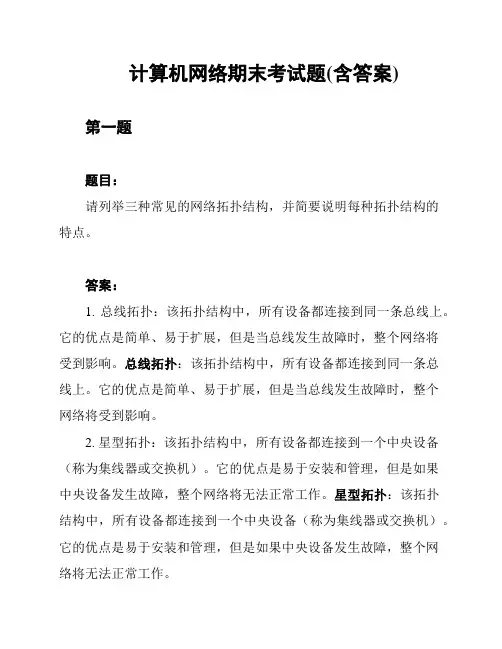
计算机网络期末考试题(含答案)第一题题目:请列举三种常见的网络拓扑结构,并简要说明每种拓扑结构的特点。
答案:1. 总线拓扑:该拓扑结构中,所有设备都连接到同一条总线上。
它的优点是简单、易于扩展,但是当总线发生故障时,整个网络将受到影响。
总线拓扑:该拓扑结构中,所有设备都连接到同一条总线上。
它的优点是简单、易于扩展,但是当总线发生故障时,整个网络将受到影响。
2. 星型拓扑:该拓扑结构中,所有设备都连接到一个中央设备(称为集线器或交换机)。
它的优点是易于安装和管理,但是如果中央设备发生故障,整个网络将无法正常工作。
星型拓扑:该拓扑结构中,所有设备都连接到一个中央设备(称为集线器或交换机)。
它的优点是易于安装和管理,但是如果中央设备发生故障,整个网络将无法正常工作。
3. 环型拓扑:该拓扑结构中,所有设备通过一个环形链路连接。
它的优点是每个设备都具有平等的通信权限,但是当环路中的一个设备发生故障,整个网络将被切断。
环型拓扑:该拓扑结构中,所有设备通过一个环形链路连接。
它的优点是每个设备都具有平等的通信权限,但是当环路中的一个设备发生故障,整个网络将被切断。
第二题题目:简要解释TCP/IP协议族中的三次握手过程。
答案:TCP/IP协议族中的三次握手过程用于建立可靠的数据传输连接。
1. 第一次握手:客户端向服务器发送一个SYN段(同步序列编号),用于请求建立连接。
客户端会将自己的初始序列号随机选择,并设置SYN标志位为1。
第一次握手:客户端向服务器发送一个SYN段(同步序列编号),用于请求建立连接。
客户端会将自己的初始序列号随机选择,并设置SYN标志位为1。
2. 第二次握手:服务器接收到客户端的SYN段后,确认请求建立连接,并发送一个带有SYN和ACK(确认)标志位的段作为响应。
服务器要在该段中将客户端的初始序列号+1,并设置自己的初始序列号。
第二次握手:服务器接收到客户端的SYN段后,确认请求建立连接,并发送一个带有SYN和ACK(确认)标志位的段作为响应。
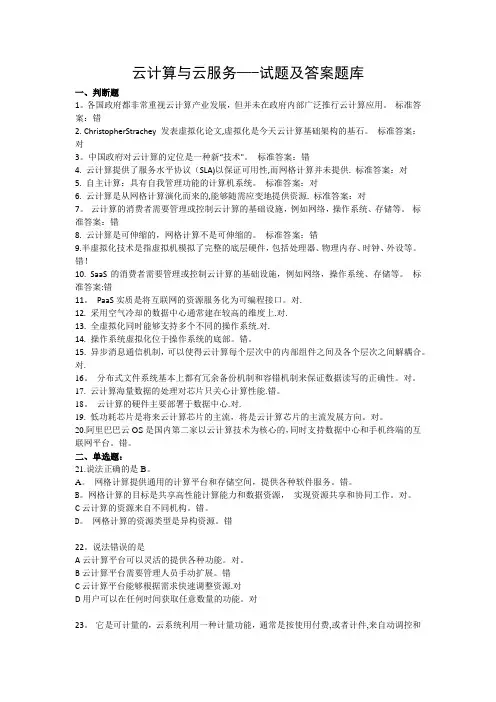
云计算与云服务—-试题及答案题库一、判断题1。
各国政府都非常重视云计算产业发展,但并未在政府内部广泛推行云计算应用。
标准答案:错2. ChristopherStrachey 发表虚拟化论文,虚拟化是今天云计算基础架构的基石。
标准答案:对3。
中国政府对云计算的定位是一种新“技术"。
标准答案:错4. 云计算提供了服务水平协议(SLA)以保证可用性,而网格计算并未提供. 标准答案:对5. 自主计算:具有自我管理功能的计算机系统。
标准答案:对6. 云计算是从网格计算演化而来的,能够随需应变地提供资源. 标准答案:对7。
云计算的消费者需要管理或控制云计算的基础设施,例如网络,操作系统、存储等。
标准答案:错8. 云计算是可伸缩的,网格计算不是可伸缩的。
标准答案:错9.半虚拟化技术是指虚拟机模拟了完整的底层硬件,包括处理器、物理内存、时钟、外设等。
错!10. SaaS的消费者需要管理或控制云计算的基础设施,例如网络,操作系统、存储等。
标准答案:错11。
PaaS实质是将互联网的资源服务化为可编程接口。
对.12. 采用空气冷却的数据中心通常建在较高的维度上.对.13. 全虚拟化同时能够支持多个不同的操作系统.对.14. 操作系统虚拟化位于操作系统的底部。
错。
15.异步消息通信机制,可以使得云计算每个层次中的内部组件之间及各个层次之间解耦合。
对.16。
分布式文件系统基本上都有冗余备份机制和容错机制来保证数据读写的正确性。
对。
17.云计算海量数据的处理对芯片只关心计算性能.错。
18。
云计算的硬件主要部署于数据中心.对.19. 低功耗芯片是将来云计算芯片的主流,将是云计算芯片的主流发展方向。
对。
20.阿里巴巴云OS是国内第二家以云计算技术为核心的,同时支持数据中心和手机终端的互联网平台。
错。
二、单选题:21.说法正确的是B。
A。
网格计算提供通用的计算平台和存储空间,提供各种软件服务。
错。
B。
网格计算的目标是共享高性能计算能力和数据资源,实现资源共享和协同工作。
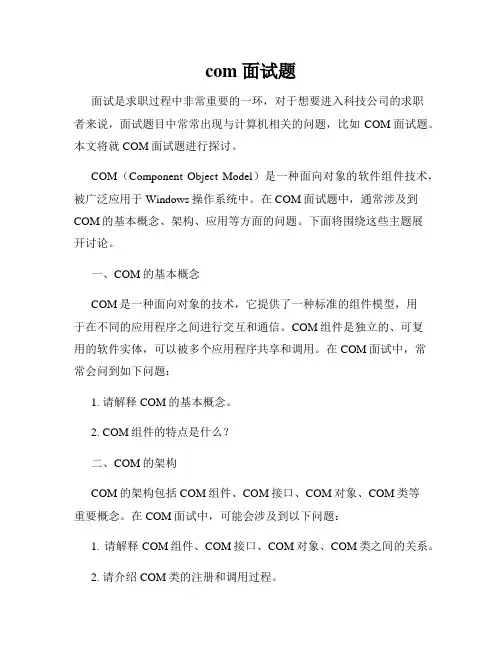
com 面试题面试是求职过程中非常重要的一环,对于想要进入科技公司的求职者来说,面试题目中常常出现与计算机相关的问题,比如COM面试题。
本文将就COM面试题进行探讨。
COM(Component Object Model)是一种面向对象的软件组件技术,被广泛应用于Windows操作系统中。
在COM面试题中,通常涉及到COM的基本概念、架构、应用等方面的问题。
下面将围绕这些主题展开讨论。
一、COM的基本概念COM是一种面向对象的技术,它提供了一种标准的组件模型,用于在不同的应用程序之间进行交互和通信。
COM组件是独立的、可复用的软件实体,可以被多个应用程序共享和调用。
在COM面试中,常常会问到如下问题:1. 请解释COM的基本概念。
2. COM组件的特点是什么?二、COM的架构COM的架构包括COM组件、COM接口、COM对象、COM类等重要概念。
在COM面试中,可能会涉及到以下问题:1. 请解释COM组件、COM接口、COM对象、COM类之间的关系。
2. 请介绍COM类的注册和调用过程。
3. COM组件如何实现版本控制和升级?三、COM的应用COM广泛应用于Windows操作系统中,为应用程序提供了强大的扩展能力。
在COM面试中,可能会问到如下问题:1. 请列举几个常见的COM组件。
2. COM组件如何被调用和实例化?3. COM技术在开发中有哪些优势和不足?四、面试技巧除了对COM面试题内容的准备外,还需要注意一些面试技巧,以提高面试表现。
以下是一些技巧建议:1. 提前准备好个人简历和项目经验介绍,以便在面试过程中展示自己的技能和能力。
2. 多进行模拟面试,熟悉面试的流程和常见问题,增强自信心。
3. 在面试过程中展示清晰的思路和良好的沟通能力,表达自己的观点和经验。
4. 注意细节,如言辞、仪态、着装等方面的表现。
总结:COM面试题涉及到COM的基本概念、架构、应用等方面的问题,要求求职者对COM技术有一定的了解和熟悉。
c证试题及答案第一部分:选择题1. 以下哪个选项是在计算机网络中用于连接两个或多个局域网的设备?A. 路由器B. 防火墙C. 交换机D. 集线器答案:A2. TCP/IP 协议族中的 IP 协议是用来做什么的?A. 控制数据传输的流量B. 在网络中定位设备C. 提供安全加密服务D. 控制数据包错误校验答案:B3. 在 OSI 模型中,负责将网络层数据包传输到物理层的是哪一层?A. 物理层B. 数据链路层C. 网络层D. 传输层答案:A4. HTTP 协议使用的默认端口号是多少?A. 80B. 443C. 21D. 25答案:A5. 在计算机网络中,以下哪个是用于将在不同子网中的数据包转发到目标子网的设备?A. 交换机B. 集线器C. 路由器D. 网桥答案:C第二部分:填空题1. IPv4 地址长度是 ______ 个字节。
答案:42. 在二进制数中,8 个位被称为 _______ 。
答案:一个字节3. 在 TCP/IP 协议中,UDP 协议是一种 _______ 传输协议。
答案:无连接4. FTP 协议使用的默认端口号是 _______ 。
答案:215. 在 OSI 模型中,网络层的协议有 _______ 。
答案:IP、ICMP、IGMP第三部分:解答题1. 简述三次握手的过程。
答案:三次握手是建立 TCP 连接时使用的一种协议。
它的过程如下:- 第一次握手:客户端发送一个请求到服务器,并且带有一个SYN 标志位,表示请求建立连接。
- 第二次握手:服务器收到客户端的请求后,会发送一个 ACK 标志位作为响应,并且还会发送一个自己的 SYN 标志位,表示接受连接请求。
- 第三次握手:客户端收到服务器的响应后,会向服务器发送一个确认的 ACK 标志位,表示连接已建立。
通过这三次握手,客户端和服务器建立起了可靠的连接。
2. 什么是子网掩码?它有什么作用?答案:子网掩码是一个与 IP 地址配合使用的网络参数。
全国计算机二级考试练习题库(含答案)全国计算机二级考试练习题库(含答案)如今试题涉及各个领域,它是考核某种技能水平的标准。
下面是店铺收集整理的全国计算机二级考试练习题库(含答案),仅供参考,大家一起来看看吧。
1、一棵二叉树中共有80个叶子结点与70个度为1的结点,则该二叉树中的总结点数为A) 219 √B) 229 C) 230 D) 2312、对长度为10的线性表进行冒泡排序,最坏情况下需要比较的次数为A) 9 B) 10 √C) 45 D) 903、下列叙述中正确的是A) 算法的效率只与问题的规模有关,而与数据的存储结构无关√B) 算法的时间复杂度是指执行算法所需要的计算工作量C) 数据的逻辑结构与存储结构是一一对应的D) 算法的时间复杂度与空间复杂度一定相关4、下列叙述中正确的是A) 线性表链式存储结构的存储空间一般要少于顺序存储结构B) 线性表链式存储结构与顺序存储结构的存储空间都是连续的√C) 线性表链式存储结构的存储空间可以是连续的,也可以是不连续的5、某二叉树共有12个结点,其中叶子结点只有1个。
则该二叉树的深度为(根结点在第1层)A) 3 B) 6 C) 8 √D) 126、对长度为n的线性表作快速排序,在最坏情况下,比较次数为A) n B) n-1 C) n(n-1) √D) n(n-1)/27、下列叙述中正确的是A) 有且只有一个根结点的数据结构一定是线性结构B) 每一个结点最多有一个前件也最多有一个后件的数据结构一定是线性结构C) 有且只有一个根结点的数据结构一定是非线性结构√D) 有且只有一个根结点的数据结构可能是线性结构,也可能是非线性结构8、下列叙述中错误的是A) 在双向链表中,可以从任何一个结点开始直接遍历到所有结点B) 在循环链表中,可以从任何一个结点开始直接遍历到所有结点√C) 在线性单链表中,可以从任何一个结点开始直接遍历到所有结点D) 在二叉链表中,可以从根结点开始遍历到所有结点9、某二叉树共有13个结点,其中有4个度为1的结点,则叶子结点数为√A) 5 B) 4 C) 3 D) 210、设栈的顺序存储空间为S(1: 50),初始状态为top=0。
通信工程师:C网电信认证找答案1、单选CDMA20001x系统的码片速率为()Mcps。
A.1.25B.1.2288C.3.84D.5正确答案:B2、多选EV-DO典型的新业务有()。
A.VTB.V(江南博哥)oIPC.BCMCSD.语音正确答案:A, B, C3、单选()是美国电信工业协会TIA于1993年确定的美国蜂窝移动通信标准,它采用了Qualcomm公司推出的CDMA技术规范。
A.IS-91B.IS-93C.IS-95D.IS-97正确答案:C4、单选广域网覆盖的地理范围可达()。
A.数公里B.数十公里C.数百公里D.数千公里正确答案:D5、多选对MMSC硬件设备基本需求包括:()。
A.硬件应采用模块化结构,便于容量扩充和引入新的硬件模块容纳新业务和新技术B.系统构成应具有冗余和容错等安全措C.设备平均无故障时间应大于5万小时D.设备能力利用率大不于70%正确答案:A, B, C, D6、单选mm4_forward.req消息中,用于指定是否要求对端回前转确认消息的字段是()。
A.X-Mms-Ack-RequestB.X-Mms-Message-TypeC.X-Mms-ReaD.ReplyD.X-Mms-Sender-Visibility正确答案:A7、多选SMSC与以下哪些模块有接口?()A.MSPB.ESMEC.OCSD.PLMNE.MSPGW正确答案:A, B, C, D8、单选对于全球眼业务,无线PU按移动属性分为固定设备、车载设备和()。
A.无线设备B.单兵设备C.手机设备D.IP CAMERA正确答案:B9、多选在LDP协议中,通告(Advertisement)消息,用于()特定FEC.标记绑定。
A.创建B.改变C.删除D.上述均不正确正确答案:A, B, C10、单选中国制定的WLAN安全标准是什么?()A.802.11sB.802.11iC.WAPI正确答案:C11、多选PDSN采用GE口作为RP口时要求()。
理论考试参考题库一、名词解释1、“四不放过”原则所谓的“四不放过”原则是指,生产安全事故调查处理必须坚持的“事故原因没有查清不放过;事故责任者没有严肃处理不放过;广大群众没有受到教育不放过;防范措施没有落实不放过”等原则。
2、特种作业特种作业是指,生产过程中容易发生人员伤亡事故,对操作者本人、他人及周围设施的安全有重大危害的作业。
3、强制性标准所谓强制性标准是指,保障人体健康,人身、财产安全的标准,以及法律、行政法规规定强制执行的标准的统称。
4、班前安全活动施工班组在每天上岗前进行的安全教育活动,称为班前安全活动。
5、工程安全专项施工方案所谓建筑工程安全专项施工方案,是指建筑施工过程中,施工单位在编制施工组织(总)设计的基础上,对危险性较大的分部分项工程,依据有关工程建设标准、规范和规程,单独编制的具有针对性的安全技术措施文件。
6、安全防护用品安全防护用品,也称劳动保护用品,是指在施工作业过程中能够对作业人员的人身起保护作用,使作业人员免遭或减轻各种人身伤害或职业危害的用品。
7、安全帽安全帽是指对人头部受坠落物及其他特定因素引起的伤害起防护作用的帽。
8、安全带安全带是指高处作业人员预防坠落的防护用品,主要由带子、绳子和金属配件等组成。
9、高处作业凡在坠落高度基准面2m以上(含2m)有可能坠落的高处进行的作业均称为高处作业。
10、临边作业施工现场,坠落高度在2m及以上的作业面,如边沿无围护设施或围护设施低于80cm 时,这类作业称为临边作业。
11、安全网在建筑施工现场用来防止人、物坠落或用来避免、减轻坠落及物体打击伤害的网具,统称安全网。
12、安全平网水平方向安装,用来承接人和物坠落的垂直载荷的安全网,称为安全平网。
13、安全立网垂直方向安装,用来阻挡人和物坠落的水平载荷的安全网,称为安全立网。
14、洞口作业在建筑施工现场的洞口旁,且有2m及以上坠落高度的作业,统称为洞口作业。
15、攀登作业施工现场,凡借助于登高工具或设施,在攀登条件下进行的高处作业,统称为攀登作业。
全国计算机等级考试一级MS Office真题题库1 2015年(总分100,考试时间90分钟)一、选择题(每小题1分,共20分)1. 组成CPU的主要部件是()。
A. 运算器和控制器B. 运算器和存储器C. 控制器和寄存器D. 运算器和寄存器2. 把用高级程序设计语言编写的源程序翻译成目标程序(.OBJ)的程序称为()。
A. 汇编程序B. 编辑程序C. 编译程序D. 解释程序3. 广域网中采用的交换技术大多是()。
A. 电路交换B. 报文交换C. 分组交换D. 自定义交换4. 计算机技术中,下列的英文缩写和中文名字的对照中。
正确的是()。
A. CAD——计算机辅助制造B. CAM——计算机辅助教育C. CIMS——计算机集成制造系统D. CAI——计算机辅助设计5. 一个字符的标准ASCII码的长度是()。
A. 7bitB. 8bitC. 16bitD. 6bit6. 以下名称是手机中的常用软件,属于系统软件的是()。
A. 手机QQB. AndroidC. SkypeD. 微信7. 若网络的各个节点均连接到同一条通信线路上,且线路两端有防止信号反射的装置,这种拓扑结构称为()。
A. 总线型拓扑B. 星型拓扑C. 树型拓扑D. 环型拓扑8. 早期的计算机语言中,所有的指令、数据都用一串二进制数0和1表示,这种语言称为()。
A. Basic语言B. 机器语言C. 汇编语言D. java语言9. 计算机网络中传输介质传输速率的单位是bps,其含义是()。
A. 字节/秒B. 字/秒C. 字段/秒D. 二进制位/秒10. 高级程序设计语言的特点是()。
A. 高级语言数据结构丰富B. 高级语言与具体的机器结构密切相关C. 高级语言接近算法语言不易掌握D. 用高级语言编写的程序计算机可立即执行11. 在微型计算机内部,对汉字进行传输、处理和存储时使用汉字的()。
A. 国标码B. 字形码C. 输入码D. 机内码12. 在标准ASCIl码表中,英文字母a和A的码值之差的十进制值是()。
1、与SaaS不同的,这种云”计算形式把开发环境或者运行平台也作为一种服务给用户提供。
A、软件即服务B、基于平台服务C、基于WEB服务D、基于管理服务2、云计算是对()技术的发展与运用A、并行计算B、网格计算C、分布式计算D、三个选项都是3、公司通过()计算云,可以让客户通过WEBService方式租用计算机来运行自己的应用程序。
A 、S3B 、HDFSC 、EC2D、GFS4、互联网就是一个超大云。
()A、正确B、错误5、不属于桌面虚拟化技术构架的选项是A、虚拟桌面基础架构(VDI)B、虚拟操作系统基础架构(VOI)C、远程托管桌面D、OSV 智能桌面虚拟化6、()不属于桌面虚拟化技术构架的选项是。
A、SAASB、PAASC、IAASD、HAAS7、与网络计算相比,不属于云计算特征的是()A、资源高度共享B、适合紧耦合科学计算C、支持虚拟机D、适用于商业领域8、云计算的基本原理为:利用非本地或远程服务器(集群)的分布式计算机为互联网用户提供服务(计算、存储、软硬件等服务)。
A、正确B、错误9、将平台作为服务的云计算服务类型是()A、I aaSB、P aaSC、SaaSD、三个选项都是10、Raid1 是备份量极高的Raid 策略,相应的他的保护能力也很强()。
A、正确B、错误11、我们常提到的"Window 装个VMware 装个Linux 虚拟机"属于()A、存储虚拟化B、内存虚拟化C、系统虚拟化化D、网络虚拟化12、IaaS 是()的简称。
A、软件即服务B、平台即服务C、基础设施即服务D、硬件即服务13、超大型数据中心运营中,什么费用所占比例最高()A、硬件更换费用B、软件维护费用C、空调等支持系统维护费用D、电费14、将基础设施作为服务的云计算服务类型是()A、I aaSB、P aaSC、SaaSD、三个选项都是15、SAN 属于A、内置存储B、外挂存储C、网络化存储D、以上都不对16、利用并行计算解决大型问题的网格计算和将计算资源作为可计量的服务提供的公用计算,在互联网宽带技术和虚拟化技术高速发展后萌生出云计算。
OCM考试指南概述:第一天:section 0:创建一个数据库 45 分钟section 1:数据库和网络配置 120 分钟section 2:Gridcontrol 安装配置 120 分钟section 3:数据库备份恢复 60 分钟section 4:数据仓库 90 分钟第二天:section 5:数据库管理 120 分钟section 6:数据库性能管理 120 分钟section 7:部署Oracle RAC 数据库 90 分钟sectoin 8:部署Dataguard 数据库 60 分钟奇数机(edsir5p1)与偶数机(edsir5p2):在真正考试时,每个人面前会有两台机器,一台称为奇数机(ODD),一台称为偶数机(EVEN),要你在ODD 机器上做什么或者在 EVEN 机器上做什么,偶数还是奇数是依靠机器的hostname 最后一位或者两位数字来定的,通常会要求你在奇数机上创建数据库,在偶数机上安装Grid Control 的OMS。
偶数机上是没有Oracle 软件的,因此OMS 需要的Repository 这个数据库也需要创建在奇数机上,再加上之后第二天会要求创建的Standby 实例。
Oracle_home/u01/app/oracle/product/10.2.0/db_1/u01/app/oracle/oradata/PROD/disk1……disk5文档路径/stage/doc/english/Gridcontrol安装文件/stage/gc/Disk1/除rac外都在奇数机edsir5p1和偶数机edsir5p2上完成,并且root密码不告诉你,oracle用户密码ocm123Rac用奇数机上的虚拟机host1和host2,root用户和oracle用户密码都是oracle使用Sudo命令Section 0 手工建库Section 0 :创建数据库(即手动建库)【在odd 机】1. Create a database the sid name is PROD2. Don't run the Script catalog.sql and catproc.sql步骤:1、搞参数文件2、搞spfile3、启动数据库到nomount4、搞生成数据库命令并执行之参考联机文档:Reference ==> Basic Initialization ParametersAdministrator's Guide ==> Step 7: Issue the CREATE DATABASE Statement考试的时候有个参数文件,但是有些参数有问题是低版本的参数,最好不要用Section 1:数据库和网络的配置【在odd机操作】1.Database setup and undo management1.1Run the minimum required scripts to complete the basic configuration of the PRODDatabase.1.2Setup automatic undo management in the PROD database to support the followingrequirements1.2.1Avoid ORA-01555 Snapshot too old errors for queries running up to 90 minuteson average.1.2.2The number or concurrent OLTP users will be approximately 120 during normalbusiness hours.1.2.3The number or concurrent batch process that will run in the evenings willapproximately 12 to 15.@?/rdbms/admin/catalog@?/rdbms/admin/catproc@?/rdbms/admin/dbmspoolalter system set undo_retention=5400;alter system set processes=135 scope=spfile;alter system set job_queue_processes=15;shutdown immediate;startup;2.Server-side Network configuration2.1Create a listener using the default listener name.2.1.1The TCP/IP protocol will be used for all e the machine (not the IPaddress) for host.2.1.2This listener will listen on the default port.2.2Add a second listener, named LSNR2, which will listen on port 1526.configure thislistener to support only automatic instance registrations.2.2.1Set up the PROD instance to automatically register with the LSNR2.2.3Start Both listeners.参考联机文档:Net Services Reference ==> 7 Listener Parameters (listener.ora)3.Shared Server configuration3.1Configure the PROD database to support up to 300 sessions, reserving 100 for decicatedconnections.3.2Configure the PROD database to support:3.2.1Default of 3 TCP dispatchers3.2.2Maximum of 10 dispatchers3.3Configure the PROD database to support:3.3.1Minimum of 10 shared server processes3.3.2Maximum of 30 shared server processesalter system set processes=300 scope=spfile;alter system set shared_server_sessions=200 scope=spfile;alter system set dispatchers = '(PROTOCOL=TCP)(DISPATCHERS=3)';alter system set max_dispatchers = 10;alter system set shared_servers = 10;alter system set max_shared_servers = 30;shutdown immediate;startup参考联机文档:Reference ==> DISPATCHERSReference ==> SESSIONSReference ==> SHARED_SERVERS4.Client-side Network configuration4.1Create the client-side network configuration files providing connect descriptors to yourdatabase using local naming and easy connect methods.4.1.1The prod alias should connect to the PROD instance using the default listenerand always use a dedicated server connection.4.1.2The prod _s alias should connect to the PROD instance using LSNR2 and use ashared server connection.4.2The racdb alias should connect to the RACDB service (created later) with a dedicatedserver conncection.4.2.1The RACDB service will be running on your RAC cluster4.3The emrep alias should connect to the EMREP instance (created later) with a dedicatedserver connection.创建sqlnet.ora,内容如下:NAMES.DIRECTORY_PATH= (TNSNAMES, EZCONNECT)参考联机文档:Net Services Reference ==> 6 Local Naming Parameters (tnsnames.ora)5.Tablespace creation and configurationNote: tablespaces must be named as specified in each task to receive credit.5.1Create a temporary tablespace group that contains two temporary tablespaces tosupport batch processing, the creation of large indexes,and analyzing tables,use the following specifications:5.1.1Temporary tablespace group named TEMP_GRP containing temporarytablespaces TEMP1 and TEMP2.5.1.2Make TEMP_GRP the default temporary tablespace for all new users.5.2Create a permanent tablespace to store sample test data. Use the followingspecifications:5.2.1Tablespace name of EXAMPLE5.2.2Initial datafile size of 400MB with the file expected to grow to 4TB.5.2.3Initial extent size of 1MB5.2.4Next extent size of 1MB5.3Create a permanent tablespace to store indexes , use the following specifications:5.3.1Tablespace name of INDX5.3.2File size of 40MB5.4Create a permanent tablespace to store data from vaious Oracle tools,use the followingspecifitions:5.4.1Tablespace name of TOOLS5.4.2File size of 10MB5.5Create a default permanent tablespace using the following specifications:5.5.1Tablespace name of USERS5.5.2File size of 48MB5.5.3Initial extent size of 4MB5.5.4Next extent size of 4MB5.6Create a permanent tablespace for storing segments associated with online transactionprocessing with high insert rates. Due to the potential high volume of concurrent inserts,every effort should be taken to reduce contention for each of the talbes that will be stored in this tablespace .use the following specifications:5.6.1Tablespace name of OLTP5.6.2File size of 48MB5.6.3Initial extent size of 2MB5.6.4Next extent size of 2MBcreate temporary tablespace temp1 tempfile '/u01/app/oracle/oradata/PROD/Disk1/temp11.dbf' size 64m autoextend on next 10m maxsize 2gextent management local uniform size 1msegment space management manualtablespace group temp_grp;create temporary tablespace temp2 tempfile '/u01/app/oracle/oradata/PROD/Disk2/temp22.dbf' size 64m autoextend on next 10m maxsize 2gextent management local uniform size 1msegment space management manualtablespace group temp_grp;alter database default temporary tablespace temp_grp;CREATE BIGFILE TABLESPACE EXAMPLE DATAFILE '/u01/app/oracle/oradata/PROD/Disk1/EXAMPLE01.dbf' SIZE 400M AUTOEXTEND ON NEXT 1M MAXSIZE 4t EXTENT MANAGEMENT LOCAL UNIFORM SIZE 1M ;CREATE TABLESPACE INDX DATAFILE '/u01/app/oracle/oradata/PROD/Disk1/INDX01.dbf' SIZE 40M ;CREATE TABLESPACE TOOLS DATAFILE '/u01/app/oracle/oradata/PROD/Disk1/TOOLS01.dbf' SIZE 10M ;CREATE TABLESPACE USERS DATAFILE '/u01/app/oracle/oradata/PROD/Disk1/USERS01.dbf'SIZE 48M EXTENT MANAGEMENT LOCAL UNIFORM SIZE 4M;CREATE TABLESPACE OLTP DATAFILE '/u01/app/oracle/oradata/PROD/Disk1/OLTP01.dbf'SIZE 48M EXTENT MANAGEMENT LOCAL UNIFORM SIZE 2M SEGMENT SPACE MANAGEMENT AUTO;参考联机文档:Administrator's Guide ==> CREATE TEMPORARY TABLESPACEAdministrator's Guide ==> CREATE TABLESPACE6.Log file management6.1Due to the expected high volume of transactions. The database should have thefollowing configuration:6.1.1 A minimum of 5 redo log groups.6.1.2Each redo log group should not be a single point of failure.6.1.3File size of 100MB6.1.4Specify the location such that it minimizes contention and reduces the risk of asingle point of failure in the case of disk driver failure6.2Triplex the controlfile to minimize recovery in case of disk drive failure.1、select a.group#,member,bytes/1024/1024 from v$logfile a,v$log b where a.group#=b.group#;查询结果有10行,每个GROUP#有两行,BYTES是100Malter database add logfile group 4 (‘’,’’) size 100m,group 5 (‘’,’’) size 100m;2、select name from v$controlfile;查询结果有三行,分别在DISK1至DISK5的其中的三个目录中。